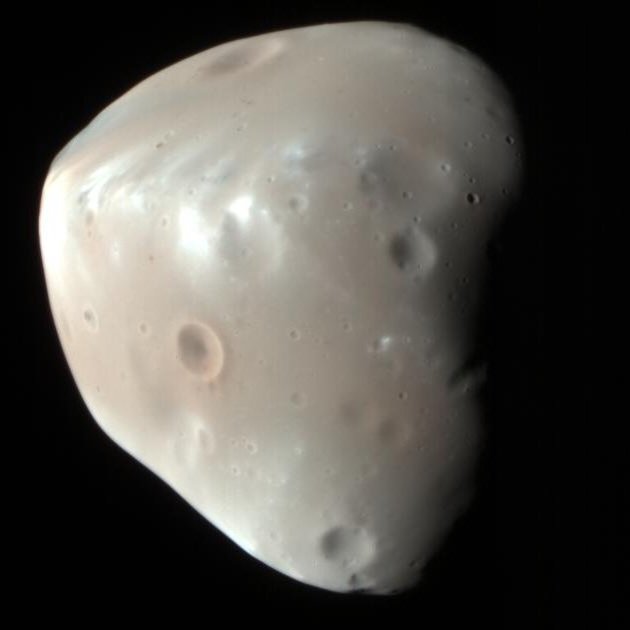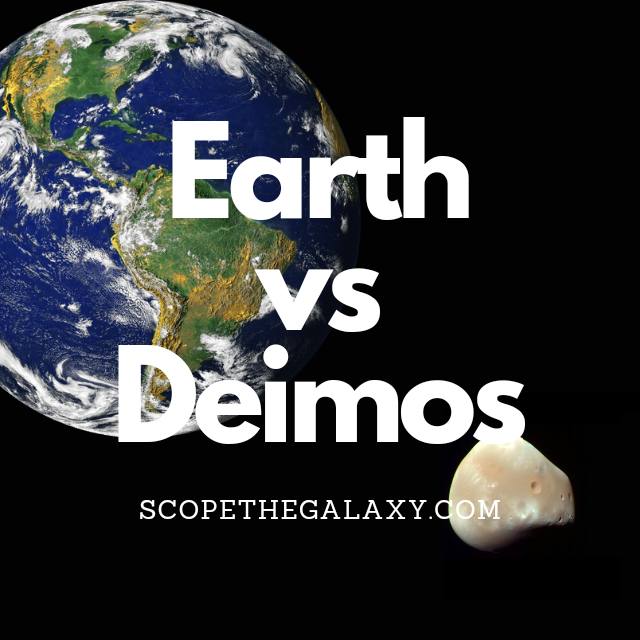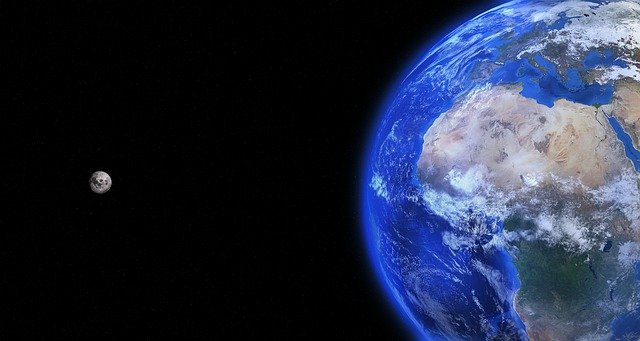*This post may contain affiliate links. This means we may make a commission if you purchase an item using one of our links*
The main differences between Earth and Deimos are that Earth is the largest terrestrial planet in our solar system with a diameter of 12,724km compared to Deimos’ diameter of 12.4km, Earth is able to sustain intelligent life while Deimos cannot and Deimos is tidally locked to Mars while Earth is not tidally locked to anything.
There are various other differences between the two so, continue reading if you want a more detailed look at both Deimos and Earth along with their similar features and differences below.
What Is The Moon Deimos?
Table of Contents

Deimos is the smaller and outermost of the two moons of Mars, named after the Greek God of dread and terror (the brother of Phobos). This satellite was also discovered by American astronomer Asaph Hall just five days before Phobos (12th August 1877).
Scientists like Johannes Kepler had put forward theories for the existence of these moons many years before they were discovered. Their calculations were based on the fact that the planets on either side (Earth and Jupiter) possessed one and four moons, respectively.
Still, none were discovered until the 19th century. One of the main reasons for this is that the tiny size of Phobos and Deimos, combined with an exceptionally close orbit to their planet, means that the glare of Mars often obscures our view of them.
Phobos measures just 15 x 12 x 11 km and completes an orbit of Mars once every 30 hours.
This tiny moon is also a heavily cratered landscape shaped by the impact of asteroid collisions over time. However, the material thrown up from these impacts doesn’t appear to have landed back on the moon’s surface as it usually would. This could be because the lack of gravity on Phobos allowed the ejected material into space.
The surface gravity on Deimos is just 0.003 m/s^2 (compared to 9.807 m/s^2 on Earth), which means the average gravitational pull of Deimos is only 0.003 m/s. With only 1/2500th of Earth’s gravity, you would need a tether to walk on this rocky moon, or every step would put you at risk of achieving escape velocity and launching yourself into space.
The composition of Deimos is similar to Phobos, suggesting that it might also be a captured asteroid. Its surface is very dark gray and has an albedo of around 0.07, meaning it reflects just 7% light (about half of the light Earth’s moon can reflect).
What Is The Planet Earth?
Our home planet Earth is the 3rd farthest planet from the Sun, made up of a mixture of water and solid rock like objects, and is the only entity in our solar system known to allow intelligent life forms like ourselves to exist.
Earth’s distance of 152 million km from the Sun has allowed it to remain within the goldilocks zone and as a result, the planet has been able to thrive for millions of years. It orbits the Sun in a circular pattern, much like all the other planets, has only one natural satellite which would be the Moon and is a terrestrial planet to boot.
In regards to its diameter, Earth is the 5th largest planet with a diameter 12,742km.
Earth’s temperature ranges based on the region you’re located where it can be from as low as -94 degrees Celsius in Antarctica to as high as 50 – 55 degrees Celsius in Tunisia.
As for the planets composition, it consists of the crust, the mantle, the outer core and the inner core, where the inner core is the hottest element within the Earth reaching temperature in excess of 5,200 degrees Celsius.
In regards to some of its most unique features, Earth is around 71% water, has an atmosphere consisting mostly of oxygen and nitrogen that is also made up of 5 main layers, with the highest to lowest being the troposphere, stratosphere, mesosphere, thermosphere and exosphere.
A day on Earth is 24 hours and an orbital cycle around the Sun takes 365 days to complete. It’s axial tilt is more distinct at 23.5 degrees to the right.
Similarities Between Deimos And Earth
Phobos and Earth do have their odd few similarities, which in this case includes the below:
- Both have a rocky surface.
- Both are a spherical shape.
- Both are part of the same solar system.
- Both have no rings surrounding them.
- Both have a neraly circular orbit
Differences Between Deimos And Earth
As for the differences between the two, they include the below.
- Deimos orbits Mars whilst Earth only orbits the Sun.
- Earth is a spherical shape while Deimos is not.
- Earth has 1 moon orbiting it while Deimos has none.
- Earth is a terrestrial planet whilst Deimos is a terrestrial based natural satellite.
- Earth has a diameter of 12,724km whilst Deimos has a diameter of 12.4km.
- Deimos has no atmosphere whilst Earth has a thicker atmosphere composed of 5 main layers.
- A day on Deimos takes 30 hours whilst an Earth day takes 24 hours.
- It takes Deimos 30 hours to orbit Mars and the Sun in 687 days whilst Earth orbits the Sun in 365 days.
- Deimos’ temperature ranges between -4 to -112 degrees Celsius whilst Earth’s average temperature is 13.9 degrees Celsius.
- Earth is the only known planet that is able to sustain intelligent life.
- Earth’s density is 5.51 g/cm³ whilst Deimos’ density is 1.47 g/cm³.
- Earth’s mass is 5.972 × 10^24 kg whilst Deimos’ mass is 1.4762 × 10^15 kg.
- Deimos’ gravitational strength is 0.003 m/s² whilst Earth’s is 9.81 m/s².
- Deimos is tidally locked to Uranus whilst Earth is is not tidally locked to any entity
- Earth has a magnetosphere whilst Deimos does not.
- Earth has volcanic activity while Deimos does not.
- Deimos has no core while Earth has a hot core.
Summary
Earth and Deimos may both be part of the same solar system and are terrestrial based but, they certainly differ more than they have in common.
Whether it be in regards to size, mass, temperature, their atmospheric composition, orbital pattern, their ability to sustain life and more so, all things considered Earth is the most unique entity in our solar system due to its ability to sustain intelligent life.


